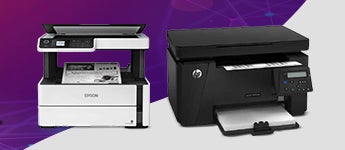A Comprehensive Guide: What Are the Four Types of Printers?
Introduction
In an increasingly digital world, printers are an essential gadget in both residential and commercial settings. They have found varied uses starting from printing personal photographs to professional documents. However, not all printers are made equal – each type has its unique set of features and it is important to choose the right one depending upon your needs. But what are the four types of printers? This comprehensive guide will equip you with the knowledge you need to answer this question and more.
What are the Four Major Types of Printers?
Let's delve into exploring the four prominent types of printers, each unique and apt for specific printing requirements.
1. Inkjet Printers
Inkjet printers are ideally known for their incredible color precision, versatility, and affordability. They effortlessly print from high-resolution images to official documents.
2. Laser Printers
For high-speed printing and high quality, laser printers rank top. They efficiently attract powdered ink to the page using static electricity, thus making them highly beneficial for larger volume printing need.
3. Dot Matrix Printers
Renowned for their durability and ability to generate multi-part forms, Dot Matrix printers are perfect for businesses that need to print packing slips, receipts, invoices, and other transaction details.
4. Thermal Printers
Highly reliable and quiet, thermal printers print by applying heat to a specific kind of paper to design images. They are primarily used in fax machines, calculators, and portable printers.
How Does an Inkjet Printer Function?
Inkjet printers display a remarkable level of efficiency and aesthetic appeal when it comes to printing. Here is a look at how they work and the benefits they offer:
- Underlying Technology: The core mechanism of inkjet printers is centered around the strategic use of ink cartridges. These components house tiny nozzles, which are programmed to spray minuscule droplets of ink onto the paper. The process is carried out line by line, meticulously recreating the desired image.
- Color Reproduction: Inkjet printers have a notable ability to depict a diverse range of colors. This capability crowns them as the go-to option when high-quality graphical printing is required.
Inkjet Printers: Pros and Cons
Upon understanding how inkjet printers function, it's crucial to weigh their advantages and drawbacks to make an informed decision:
Pros:
- Quality: These printers render a vibrant, high-res color output, outdoing the competition when it comes to detail.
- Versatility: Inkjet printers can handle a wide array of media types – be it glossy photo paper, textured stationery, or plain paper.
Cons:
- Drying Time: Inkjet prints often require some time to dry. If the printouts are handled immediately after printing, the ink may smudge.
- Running Costs: Although the initial investment is less, the continual need for replacement cartridges can add up, making them potentially costlier in the long run.
Before choosing a printer, it's essential to consider the kind of printing you'll be doing most often and factor in the ongoing costs of ink or toner replacement.

Why Consider a Laser Printer?
Are you pondering why you should think about purchasing a laser printer? Laser printers embody efficiency and quality, combining them into an ideal package for office environments and personal use. This segment delineates the varied functionalities and advantages of laser printers, delivering a clear picture of their worth.

Key Functionalities of a Laser Printer:
- Speed: Laser printers are known for their high-speed output. It's ideal for high volume print jobs, streamlining the workflow and increasing productivity.
- Quality: The print quality of laser printers is hard to surpass. They're designed to deliver sharp, precise prints, which makes them perfect for detailed graphics and text.
- Cost-Efficiency: Although the upfront cost of a laser printer might seem high, the operating cost per page significantly less in the long run than an inkjet printer.
Important Considerations for a Laser Printer:
- Space Requirements: Due to their relatively large size, you will need ample desk space to accommodate the printer.
- Initial Costs: Laser printers are more expensive upfront compared to other printers - though the long-term cost can often be more economical.
- Noise Level: Laser printers are generally louder than their counterparts – so if you prefer a quiet environment, this might be a factor to consider.
In brief, laser printers bring a high degree of efficiency and quality to the table, but they do have certain considerations to keep in mind. Make sure to assess both the upsides and downsides carefully to make a choice that fits your specific needs perfectly.
What Makes Dot Matrix Printers Unique?
Noteworthy for their durability and resilience, Dot Matrix Printers unabashedly maintain their position in the printing realm. They employ an impact-based method where a print head impacts directly on the paper to print characters and graphics. The set of closely spaced dots resulting from the pinning action form the desired characters or images.
Highlighting Features:
* Multi-part printing: Dot Matrix Printers can print multiple sheets simultaneously, making them an excellent choice for multi-part forms such as invoices and receipts.
* Reliability: Their simple design and lack of sophisticated components lead to less operational issues, making them extremely reliable for persistent usage.
* Cost-effectiveness: With comparatively lower initial costs and affordable consumables, Dot Matrix Printers can prove to be a cost-effective choice in the long run.
Potential Drawbacks:
* Quality: The quality of printouts from a Dot Matrix Printer is relatively low compared to its counterparts. It may not be the best choice for high-resolution images or crisp, clean text.
* Noise: The mechanism of striking pins against the ribbon to create characters makes Dot Matrix Printers louder than other printer types.
Usage Preferences:
While Dot Matrix Printers may not be ideal for photo printing or high-quality document printing, they are still in demand for specific applications like invoices, receipts, and shipping documents.
Conclusion:
Dot Matrix Printers may appear somewhat dated in the current world of advanced printing technologies. They aren't suitable for high-resolution tasks but their reliability, robustness, and suitability for multipart forms continue to serve many businesses efficiently. It's a matter of choosing the right tool to meet your unique printing requirements.
Thermal Printers: Are they Efficient and Useful?
Thermal printers represent cutting-edge technology in the world of printers. Featuring a compact design and innovative heat-application method for creating images or text, their efficiency and functionality raise a question - are thermal printers useful and efficient?
Thermal Printing - A Detailed Insight
The primary function of a thermal printer rests on the application of heat to a specially layered thermal paper or a thermal transfer ribbon. This heat exposure elicits a colour change on the thermal paper or ribbon, resulting in the formation of images or text. Known for high-speed operation and quiet processing, thermal printers have taken their place in several commercial and retail scenarios.
The Highlights of Thermal Printing
- High Speed: Arguably one of the added benefits of thermal printers is their speed. They work swiftly in producing readable prints, thereby saving valuable time.
- Quiet Operation: Unlike several other printers, thermal printers stun with their soundless, or barely audible operation.
- Quality Prints: The application of heat technology ensures crisp and clear print quality.
- Compact Size: Thermal printers are renowned for their small, lightweight, and portable design, making them ideal for point-of-sale applications.
Possible Drawbacks
Despite several benefits, thermal printers do come with a potential downside:
- Limited Longevity: The thermal prints tend to fade over time, especially under exposure to direct light or heat.
The evaluation of the efficiency and usefulness of thermal printers doubles down on purpose and functionality. For environments such as retail settings, where speed, compact size, and quiet operation are paramount, thermal printers are indeed efficient and highly useful.
Conclusion
The functioning of an Inkjet printer primarily revolves around the use of ink cartridges. Within these cartridges, there are minute nozzles that spray tiny droplets of ink onto the paper. This is typically done line by line until the entire image is recreated. These printers can reproduce a remarkable range of colors making them ideal for printing graphics.
The major advantage of Inkjet printers is their ability to produce vibrant color outputs with high quality detailing. However, inkjet printouts do have a longer drying time, there’s a possibility of the ink smudging if handled immediately post printing.
Related FAQs about what are the four types of printers
What are the pros and cons of each type of printer?
Inkjet printers are known for their precision in color reproduction and affordability. However, they have longer drying times and potential high running costs. Laser printers have high-speed output and quality, but they are larger and relatively noisy. Dot Matrix printers are durable and excellent for multi-part forms but have lower printing quality. Thermal printers are fast, quiet, and have excellent print quality but their prints tend to fade over time.
How do I decide which type of printer is right for me?
Choosing the right printer depends on your specific requirements. You should consider the volume and type of printing tasks, the upfront and running costs, space constraints, and noise factor. For high-quality images, consider Inkjets. For high-volume, frequent printing, choose laser printers. If you need continuous printing like receipts or invoices, go for Dot Matrix, and if speed and quiet operation are crucial, choose thermal printers.
Which is the most cost-effective printer type?
The cost-effectiveness of printers depends on your usage. If you print infrequently, inkjet printers with lower upfront costs may be most economical. For voluminous, regular printing, the per-page cost of laser printers makes them cost-effective. Dot Matrix and Thermal printers also have lower running costs making them cost-effective for businesses.


